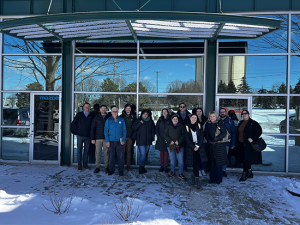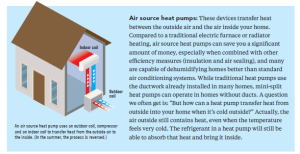
By David Weaver
Carbon Free Buildings Coordinator
Do you have questions about Air Source Heat Pumps (ASHPs)? What are they? How do they work? Are they capable of heating my home in the winter? Will they save me money? Should I make the switch?
These are all important questions that we get asked almost daily here at CUB, and to make sure we are able to provide the most accurate information to our consumers, I had to start researching and asking some experts.
What are air source heat pumps and how do they work?

Heat pump systems are another method for heating and cooling your home in a more energy-efficient and cost-effective manner. Much like a refrigerator, heat pump systems utilize electricity to move heat from cool spaces to warm spaces and vice versa. Because heat pump systems move heat rather than generate it, they are a more economically sound way of warming your home. This is because when properly installed, an ASHP can provide 300% more heat energy to a home than electricity used. ASHPs can use a home’s existing ductwork or use mini-splits. Mini-splits have a head that goes up on the wall and depending on your home’s needs you can install heads in various rooms with each controlled separately.
Are they capable of keeping my home comfortable?
ASHPs are more efficient at cooling homes than air conditioning units and should have no issue keeping homes cool in the summer as long as they are properly designed. In fact, as many models of ASHPs, especially cold climate heat pumps, have variable speed compressors, they are often considered more comfortable than A/C units because they can maintain a steady temperature, whereas A/C units often have to turn on and off throughout the day causing significant temperature fluctuations in the home.
Cold Climate ASHPs operate more efficiently and less expensively than furnaces, electric resistance heaters and broilers. Of course this efficiency advantage lessons on frigid days, when the temperature drops below zero for an extended period of time. Some models are designed to work with backup electric heating or another system that kicks in at a certain temperature. However, a properly designed cold climate air source heat pump can keep a home comfortable even on days when the ambient temperature goes below -13 degrees. One way to improve the performance of your heat pump is to make sure your home is properly insulated and weatherized.
John McKinnon installed a heat pump to cool and heat his family’s home, a more than 100 year-old building in Chicago that didn’t have air conditioning. “We were already interested in energy efficiency and to stop using polluting fossil fuels, (fortunately) the upfront costs of the heat pump (which cools and heats) were almost the same as putting in a new A/C system,” he wrote. “So to us it wasn’t much of a choice because we saved money with energy efficient rebates, will continue to save money over time, and it was another move towards electrifying our building.”
The ASHP performed well in their first summer and winter. “The temperature is very balanced with units installed throughout our home, “ he said. (Got a good story about a heat pump? Reach out to CUB’s Zoe Huspen.)
How should I begin the process of switching to ASHPs?
- Start planning now. Don’t wait until your old heating or cooling system fails–plan ahead to determine the best contractor and best replacement. A crisis is not a good time for such important decisions: It can be expensive because contractors may charge extra for emergency service, and if your home is cold, you’ll be pressed for time and may be tempted to buy the latest model of your old, inefficient system.
- Weatherize your home. The first step for switching to an ASHP should be to complete a free Home Energy Assessment and/or a Home Energy Audit. The free Home Energy Assessment or the much higher quality Home Energy Audit will help you prioritize insulation and weatherization projects for your home. Home Energy Assessments, which take up to 90 minutes, are utility-run programs where an energy expert tours your home to make energy efficiency recommendations and can provide (and install) energy-saving products (LEDs, low-flow shower heads, pipe insulation) for free. The Home Energy Audit–a much more comprehensive process that can take several hours–will test your home and show you where you lose heat due to unsealed windows or a lack of insulation. Improving your home’s insulation will not only help you save money and make your home more comfortable, but it is a critical first step to installing a heat pump so you can insure you are “right-sizing” your heat pump and not getting a heat pump that is more powerful (and expensive) than what your home needs. (Pro tip: Avoid extruded polystyrene insulation to minimize your carbon emissions!)
- Shop around to find quality heat pump Installers. Most ASHP manufacturers certify installers and list them on their websites (Mitsubishi, Daikin, Carrier, LG, Trane, etc). This is a great starting place to find qualified installers. You should get at least three quotes and make sure you feel comfortable with an installer’s professionalism, competency and price. Also, check the Better Business Bureau to determine if there have been any complaints filed against the company. Take note: Just because a company is certified doesn’t mean the individual installer serving you is. Verify that the employee designing, installing and maintaining your system is certified by that manufacturer.
- Insist on load calculations. If you’re getting a ductless heat pump for the main living space and it’s clear that it won’t heat the whole house, it may be fine to estimate the heat pump size based on installer experience. But if you want to heat your entire home, the proposal should always start with a load calculation. This means the installer measures the rooms and window dimensions and makes a list of the insulation values in attics, walls, and basements, along with window types and direction. All these details are needed to calculate the amount of necessary heating and cooling to keep the house comfortable (called heating and cooling loads). This is often called a “Manual J” (the name of a widely recognized load calculation procedure). “Bigger” is not “better” when it comes to heat pumps. In fact, “too big” can create significant performance problems. For multi-zone systems, it is extremely important to calculate loads correctly and avoid indoor units that are too large for the rooms they serve. Central systems and single-zone systems (ductless or ducted) are somewhat more forgiving, because they allow for a wider range of efficient operating conditions.
- Ask questions! Consider asking your prospective installer the following questions to ensure you are working with a true professional to design and install your new heating and cooling system.
- Can you provide references from previous customers with similar systems?
- How many heat pump systems have you personally designed and installed?
- Have you participated in manufacturer training for this specific system?
- What level of certification do you (NOT YOUR COMPANY) have with this heat pump’s manufacturer?
- What are the available incentives or rebates, and will you aid in applying for them?
- Will I need to hire my own electrician to provide the electrical work? Will I need any electrical service upgrade to accommodate the heat pumps? (This is not unusual in older houses.)
- Do you use the NEEP Sizing and Selecting Guide and ColdClimate Installation Guide to inform your work?
- Can you walk me through the heat gain and heat loss calculation? (They may not provide this on the first walk through, but should be able to on the second.)
- Do you use appendix J for the heat gain heat loss calculation?
- Will you choose equipment from the NEEP cold-climate air source heat pump list, and use the information in the listing to help size the system properly?
- Where will you mount the outdoor unit(s), and how? (Brackets bolted to an exterior wall may create unwanted noise in a sensitive area like a bedroom; ground-mounted units should always be on a stand to keep them above the normal snow line. Units should also be shielded from wind, rain, and snowmelt dripping off the roof.)
- If exterior “line sets” (piping) will be visible, where will they be placed?
- What type of indoor units are you recommending, where will they be located, and why?
- Do you recommend a wall-mounted thermostat or control? (This is needed for ducted systems. For ductless units serving larger spaces, it can enhance comfort by sensing the temperature in a central location.)
- Do you always perform a triple evacuation before charging the refrigerant lines?
- Will you use any subcontractors in the process? If so, who are they and what jobs will they do?
- Will you provide training for me on how to properly operate and maintain the system?
- Do you provide a warranty for the systems you install, and how long is it?
- Do you register the heat pump with the manufacturer (the answer should be yes!)?
- Can I get a quote that details the equipment model numbers and itemizes any other parts and accessories for which I’ll be charged? (Always ask this.) If possible, try to get options for two or three alternatives from the same contractor so you can consider a range of choices, with some explanation of the differences and the benefits of each.)
What’s this going to cost and save me?
There are many variables when factoring in both the upfront cost and energy savings associated with ASHPs. However, Rewiring America estimates the representative upfront cost before incentives is $8,000 for a 1,500 square foot home, $14,000 for a 2,000 square foot home, $20,000 for a 3,000 square foot home, and $35,000 for a 4,000 square foot home. However, these prices can vary significantly based on the home, labor costs, and model type. Fortunately, there are many incentives to help reduce the cost of ASHPs.
The Inflation Reduction Act currently provides a tax credit of $2,000 for all consumers purchasing an ASHP and will provide rebates of up to $8,000 for lower- and moderate-income consumers starting in the spring or summer of 2024. Learn more about IRA incentives here. Additionally, your electric utility company may offer a rebate or discount as well. For example, ComEd offers a rebate ranging from up to $1,350 to $2,000, depending on the type and energy efficiency quality of the ASHP.
ASHPs are much more energy efficient than furnaces and A/C units, so they should also save you a lot of money. However, the amount of cost savings depends on the changing price of natural gas and electricity. In the state of Illinois, we have a relatively high cost of natural gas and low cost of electricity, which helps make this a smart decision. Furthermore, when you switch to electric heating, your electric utility company may offer you a lower rate, helping to save even more money. Additionally, because the ASHP replaces both the furnace and A/C unit, this can cut your yearly maintenance costs. Finally, if you fully electrify your home, you can eliminate the fixed costs from your gas utility company, potentially saving you hundreds of dollars a year, depending on your gas utility company.
Learn More:
- IRA Incentives Guide: https://citizensutilityboard.salsalabs.org/ira/index.html
- Home Electrification Guide: https://citizensutilityboard.salsalabs.org/betterheat/index.html
- Heat Pump Factsheet: https://www.citizensutilityboard.org/wp-content/uploads/2021/08/Heat-Pumps.pdf
- Department of Energy ASHP Page: https://www.energy.gov/energysaver/air-source-heat-pumps
- Consumer Reports: https://www.consumerreports.org/heat-pumps/can-heat-pumps-actually-work-in-cold-climates-a4929629430/
About the author: David Weaver joined CUB in October 2022 after ten years of active duty Marine Corps service. His focuses include building decarbonization policy, educating consumers about electrification and energy efficiency, and bolstering relationships with stakeholders in the community. He earned his bachelor’s degree from Marquette University and his master’s degree from Prescott College. In his free time, David enjoys hiking and backpacking, cooking, and reading.

